In this post, we hear from Matt White, who shares with use some of his experience and observations about masks for the blind. This is part of a series of guest blog posts where we get a chance to hear voices and perspectives about making masks more accessible.

With government agencies around the country and around the globe adopting policies that recommend, or in some cases mandate, the use of masks by the general public to limit the spread of SARS-CoV2, it is important to consider, and address, mask accessibility issues faced by underserved communities.
Full disclosure, my name is Matt and I am blind, have been since birth. Although in many ways my experience with masks during the COVID-19 pandemic is similar to that of my sighted peers, I’ve observed some areas where accessibility could be improved, and discovered some unexpected challenges being faced by some people within the blind community.
In this post, I share some advice for mask makers based on my personal experience, and discuss the need for additional research to investigate emerging concerns about the effect of face masks on spatial awareness.
Advice for Mask Makers
My advice for the maker community is to strive to make information and designs as accessible as possible. When writing instructions, do your best to make the text stand alone, with images as supporting material, not the core of the presentation. Describe your product using phrases that make sense tactilely as well as visually.
More specifically, to improve accessibility for people with visual impairments take into consideration:
Information Access: Do words alone convey all of the important content in your social media posts? On your website? Include descriptive captions of all the images, memes, and diagrams shared. For web design, use well-captioned images, pay attention to text lay out, and use headings to make navigation more logical.
Tactile Cues: Can you put on, and take off, your mask correctly in the dark with your eyes closed? If not, consider making some changes to the mask design. Indicate which side goes up using queues that are interpretable by blind and other tactilely oriented consumers. If there are differences between the inside and outside of the mask, those should be indicated as well. Finally, be descriptive when providing orientation directions for your product.
My Experience with Masks
My specific experience has shaped my perspective on finding information about mask designs, wearing masks, and mask maintenance. When it comes to information access, finding mask designs isn’t an issue, there are tons of DIY mask designs out there. The problem is that the majority of the information about mask designs is conveyed with images, photographs, and diagrams that do not translate well into text.
Similarly, a lot of the information and instructions for wearing masks correctly (i.e. donning and doffing) is provided exclusively with visuals and embedded within infographics. Without previous mask experience, it probably would have taken me a while to sort out what I was supposed to do with the strange piece of cloth with strips hanging off the edges that people call a mask.
Luckily I had prior hands-on experience with masks so already knew how to safely put on/take off masks. As a result, when my MakerMask: Surge (Oleada) arrived, I pulled it out of the box and was able to identify the various components of the mask to correctly orient it: the nose bridge should be a stiffened section at the top of the mask, the pleats should be designed to fall down and away from the nose (logical since you don’t want gunk collecting in the pockets created by the pleats), and that the seams would be palpable on the inside of the mask and not the outside.
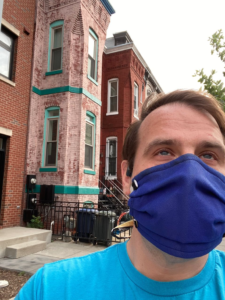
Mask Maintenance
For mask maintenance the cleaning/disinfection is not much of a challenge; if you can boil pasta, you can disinfect your NWPP mask. Although I have to admit, I use my Instapot to disinfect my mask, which is even easier. Inspecting the mask for wear and tear is more of a challenge. Most instructions direct the user to “visually inspect the mask for wear and tear,” which doesn’t work for me. Instead, I take extra care with hand hygiene and palpate the mask, feeling for holes, areas where the material is thinning or fraying, or any other signs of changes to the texture and quality of the materials.
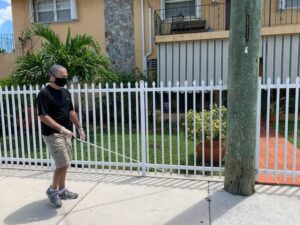
Emerging Questions: Masks and Spatial Awareness
For most people, the sense of sight predominates their spatial awareness and the strategies they use for navigating through their daily environments. However, cues from other senses including tactile cues from touch, auditory cues from hearing, and olfactory cues from smell can all be used for spatial awareness (e.g., the perception of the relative locations of oneself and other objects in ones environment) and navigation.
 Navigating while blind relies on a few different skills, some taught, some learned. Typically, a person who has formal “mobility training” is taught to use a cane. The iconic white cane is held out in front of the blind person and is used to detect objects in the path of travel. One of the standard techniques involves keeping the cane’s tip in contact with the ground, sweeping it back and forth, with the goal of locating obstacles, drop-offs, that sort of thing. The cane tip can also be lifted slightly off the ground and tapped.
Navigating while blind relies on a few different skills, some taught, some learned. Typically, a person who has formal “mobility training” is taught to use a cane. The iconic white cane is held out in front of the blind person and is used to detect objects in the path of travel. One of the standard techniques involves keeping the cane’s tip in contact with the ground, sweeping it back and forth, with the goal of locating obstacles, drop-offs, that sort of thing. The cane tip can also be lifted slightly off the ground and tapped.
A cane is an extremely useful tool for finding obstacles, but it does not tell you much about your environment unless it actually collides with something. This is where another skill comes into play, something that I usually call “passive sonar” but that is more commonly known as echolocation.
As you are moving through your environment, sound waves are constantly moving around, emanating from their source, bouncing their way to your ears. As this article points out, “Some blind humans have developed echolocation, as a method of navigation in space.”
The way this “perception of far space” generally works is that a blind person (or a sighted person trained not to override this sense) hears the sounds as they bounce off of objects in their environment, including themselves. The brain processes these sounds, and helps construct a map of the environment, letting you know that there is, for example, an open space to your left, that a tall and narrow object is in front of you, or that there is some sort of object moving away from your right-side.
So, what does this have to do with wearing a mask? Starting in late April, I began reading accounts from blind people on social media indicating that their sound-based spatial awareness seems to be compromised when wearing a mask. Blind mask wearers report having difficulty perceiving distances to objects, leading to unfortunate head-meets-pole incidents, among other oddities.
This immediately sparked my curiosity, if for no other reason than that I, as a blind mask wearer, had never experienced any such issues. I responded to a few of the comments, asking for more information—what type of mask was it, what was it made of, how was it attached, etc.
Armed with a handful of responses, I reached out to Dr. Jocelyn Songer, founder of MakerMask.org and a long-time friend. With her background in auditory research, I thought she might have some ideas on what was causing the altered perception. One potential cause came to mind, that the cotton material of the typical homemade face mask was likely to absorb quite a bit of sound, altering the perception of sound and interfering with the blind person’s spatial awareness. She also suggested that olfactory spatial cues would be modified by the masks (you don’t smell other people, e.g. perfume and cigarettes, until they are closer to you), as would any tactile cues from the face (like the warmth of the sun, or wind, on the face).
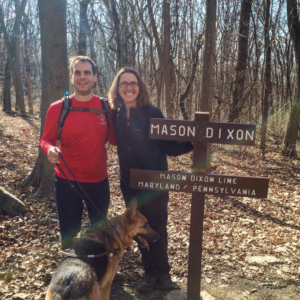
Since MakerMask designs rely on non-woven polypropylene (NWPP), Dr. Songer thought it might be useful to send a handful of NWPP masks out to blind people reporting these issues. The hope is to see if there will be an appreciable difference in the wearer’s spatial awareness. At this point, we are still in the information gathering phase. I am hopeful that working with the MakerMask team to investigate or identify solutions for unique challenges like this, we can address the issues facing the blind and other underserved communities.
Additional Information and Perspectives
There is very little information about the experiences of other blind people navigating during the COVID-19 pandemic. We found this one video discussing COVID-19 from the perspective of a blind woman in Hong Kong, but it wasn’t very accessible for English-speaking blind audiences (it had English subtitles, but no transcript or English audio). The link to the video, as well as the transcript (thank you Dr. Songer) are included below:
Coronavirus: Trying times for the blind and visually impaired who rely heavily on sense of touch (posted April 16, 2020) by the South China Morning Post:
“Simple coronavirus prevention tips such as: place the coloured side of your mask to the front” or “keep a safe distance from others” are impossible to follow for people who are blind or visually impaired. Individuals from Hong Kong’s blind community recently explained how their dependence on non-visual environmental cues, including sound or touch, becomes even more challenging when the world is fighting a deadly Covid-19 pandemic.”
Link
- This link from the Massachusetts Commission for the Blind, Five Tips for Face Mask Safety For People who are Blind and Visually Impaired (May 8, 2020), acknowledges that the existence of a potential orientation associated with masks for the blind.
References
- Flanagin VL, Schörnich S, Schranner M, et al. Human Exploration of Enclosed Spaces through Echolocation. J Neurosci. 2017;37(6):1614-1627. doi:10.1523/JNEUROSCI.1566-12.2016


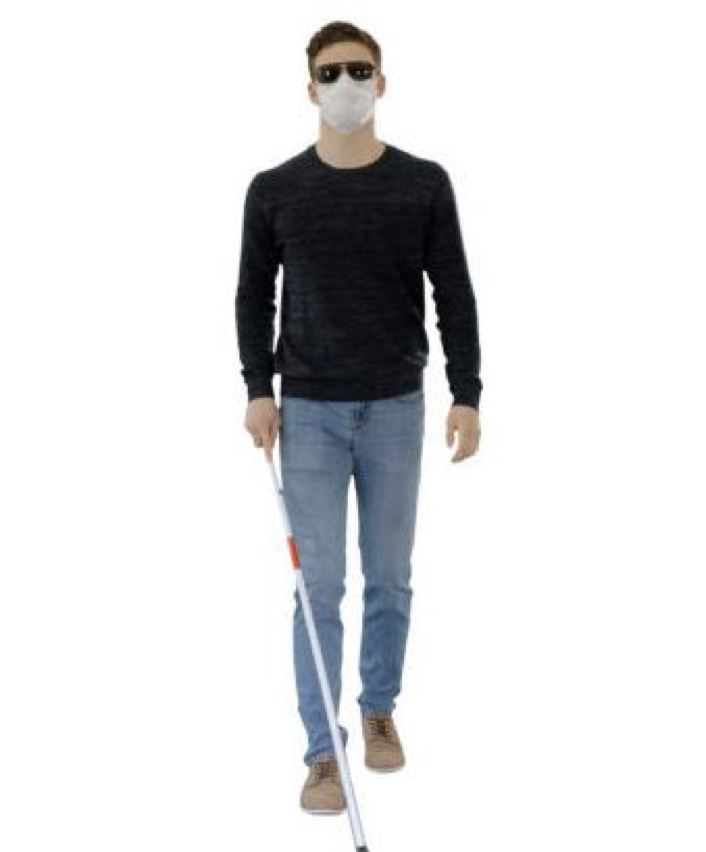
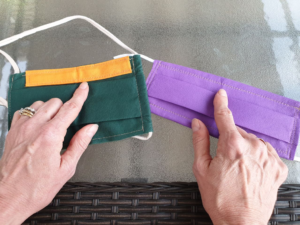
wonderful that issues regarding directives, products and signage are being addressed for the blind, visually impaired and deaf blind population. My husband is blind and I understand the disparities during this pandemic are many.
Could the earloops pulling too tightly on the ears affect the sound perception? Earloops can distort the shape of the ear, especially if they are too tight. Would an over the head style of attachment be preferable? I make masks and am genuinely curious about getting things right for every group of people. Thank you for this article, and I will keep all the tactile tips in mind.
Lisa, great question. From the limited anecdotal data that I was able to collect, ear loops vs. head ties did not seem to be the culprit for the spatial awareness problems reported. Ear loops can affect ear shape but that does not seem to be the whole story here. We need more data, hope to have a survey in-place shortly.
Greate pieces. Keep writing such kind of
info on your blog. Im really impressed by it.
Hello there, You’ve done an excellent job. I’ll certainly digg it and individually recommend to my friends.
I’m sure they will be benefited from this web site.
There is definately a great deal to know about this topic.
I really like all the points you’ve made.
I was very pleased to find this website.
I need to to thank you for ones time just for
this fantastic read!! I definitely enjoyed every
little bit of it and i also have you saved as a
favorite to look at new things in your site.
Check out my web-site … http://liveinternet.ru/
Hi, just wanted to mention, I love this article. It was inspiring.
Keeep on posting!
I suffer from wet and & glaucoma and required to wear a mask for one hour during an exercise class. This facility claims to refuse the right to dismiss a disabled person. I am legally blind and enrolled with my local braille institute. How do I fix this,